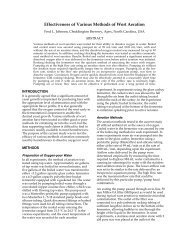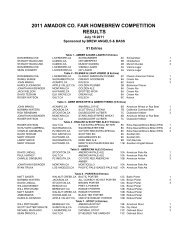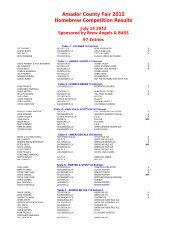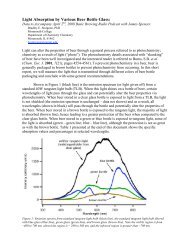A Homebrewer's Guide to Beer Flavor Descriptors - Brew Angels
A Homebrewer's Guide to Beer Flavor Descriptors - Brew Angels
A Homebrewer's Guide to Beer Flavor Descriptors - Brew Angels
Create successful ePaper yourself
Turn your PDF publications into a flip-book with our unique Google optimized e-Paper software.
Solventlike is a very general term—the flavor<br />
could arise from any number of causes. In commercial<br />
beers, such flavors have arisen from lacquers<br />
used <strong>to</strong> line cans. However, the most common<br />
source is the presence of ethyl acetate produced by<br />
a biosynthetic route during fermentation, in which<br />
ethanol is esterified by acetic acid. As with most<br />
esters, it tends <strong>to</strong> be produced in increasing<br />
amounts at higher fermentation temperatures.<br />
Certain wild yeasts are capable of producing large<br />
amounts of ethyl acetate, especially if the fermentation<br />
is aerobic. The taste threshold of ethyl<br />
acetate is only 33 parts per million.<br />
This has <strong>to</strong> be regarded as an undesirable<br />
flavor component of most beers, although amounts<br />
well above the threshold level have been detected<br />
in Belgian lambic and gueuze beers. The presence<br />
of a solventlike flavor may be acceptable in a<br />
strongly flavored dark beer, but can be very objectionable<br />
in pale beers, especially in light lagers.<br />
If the solvent flavor arises from some outside<br />
contamination, such as reaction of plasticizers<br />
present in plastic brewing equipment, it clearly<br />
represents a major beer defect.<br />
Good brewing techniques should prevent any<br />
problem occurring with this off‐flavor. If you use<br />
plastic equipment, make sure it is food‐grade, soak<br />
it with a solution of one teaspoon washing soda per<br />
gallon of water, and rinse with two teaspoons of<br />
chlorine bleach diluted in one gallon of water<br />
before use.<br />
Be scrupulous in sanitizing all your equipment,<br />
and avoiding contact with air at every stage<br />
<strong>to</strong> prevent bacteria or wild yeast from getting in<strong>to</strong><br />
the wort or beer. Use a good‐quality, true beer<br />
yeast, and control ester production by keeping<br />
fermentation temperatures from rising <strong>to</strong>o high.<br />
This means not above 75 degrees F for ales, and<br />
preferably not above 55 degrees F for lagers, especially<br />
the lighter, paler varieties.<br />
Sour/Acidic<br />
By David Logsdon<br />
Sour and acidic flavors in beer are readily<br />
identifiable through the sour aroma and tartness<br />
or vinegarlike flavors. The two most prevalent<br />
souring acids in beer are acetic and lactic acid.<br />
Bacterial infection can sometimes be identified by<br />
turbidity and ropiness in beer.<br />
The sour aroma can be perceived as bacteria<br />
spoilage of putrefaction. Acid stimulates the sides<br />
of the <strong>to</strong>ngue; at high acid levels stimulation can be<br />
felt all the way down the throat.<br />
Certain yeast strains produce more acid, giving<br />
beer a citrus flavor. Lactic acid produced by<br />
lac<strong>to</strong>bacillus and pediococcus bacteria can be introduced<br />
by low mash temperatures, by airborne<br />
infection in open fermenters, and by unsanitized<br />
equipment in contact with beer after the kettle<br />
boil.<br />
Acetic acid is most often produced by the<br />
bacterium ace<strong>to</strong>bacter through airborne infection<br />
during fermentation or via the red‐eyed fruitfly,<br />
drosophila.<br />
The flavor threshold of acid is approximately 300<br />
ppm.<br />
Sour and acidic flavors are generally, unfavorable.<br />
However, Belgian lambic style beers<br />
are acidic because of open fermentation producing<br />
a balance of lactic acid and fruity sweetness and<br />
tartness. Having the proper sugar‐<strong>to</strong>‐acid ratio<br />
creates the balance in this style of beer.<br />
Unwanted lactic and acetic acid is controlled<br />
SPECIAL ISSUE 1987 ZYMURGY 49






